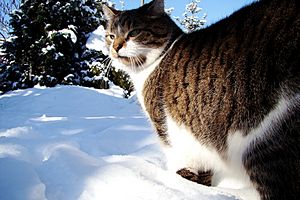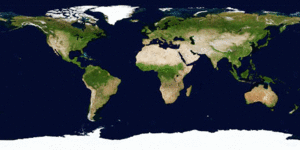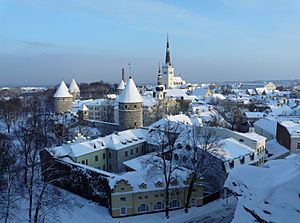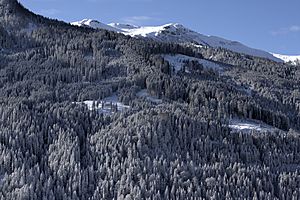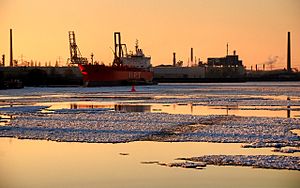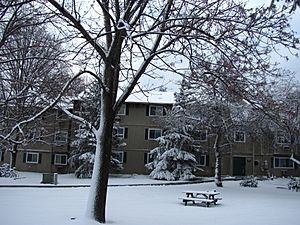Winter facts for kids

Winter is the coldest time of the year. It is one of the four main seasons. Winter comes after autumn and before spring.
Winter usually starts around the winter solstice. In the Northern Hemisphere, this is often on December 21 or December 22. In the Southern Hemisphere, the winter solstice is usually on June 21 or June 22. During winter, the days are shorter and the nights are longer.
Some animals hibernate during this season, meaning they go into a deep sleep. In places with a temperate climate, deciduous trees lose their leaves in winter. One of the big winter holidays in the Northern Hemisphere is Christmas.
The word "winter" comes from an old Germanic word. It means "time of water" because of the rain and snow that falls in many parts of the world during this season.
Contents
Why Do We Have Winter?
The main reason for winter is how the Earth is tilted. Our planet's axis is tilted at an angle of about 23.44 degrees. As the Earth travels around the Sun, this tilt means different parts of the Earth get more direct sunlight at different times of the year.
When it's winter in the Northern Hemisphere, that part of the Earth is tilted away from the Sun. This means the Sun's rays hit it at a slanting angle. The same amount of sunlight is spread out over a larger area, making it feel colder. Also, the sunlight has to travel through more of the Earth's atmosphere, which can block some of its warmth.
At the same time, the Southern Hemisphere is tilted more towards the Sun, so it experiences warmer temperatures and summer. When the Southern Hemisphere has winter, the Northern Hemisphere is tilted towards the Sun and has summer.
How Do We Measure Winter?
People define winter in a few different ways:
Meteorological Winter
Meteorologists (scientists who study weather) define winter based on the coldest average temperatures. This helps them keep consistent weather records.
- In the Northern Hemisphere, meteorological winter is usually December, January, and February.
- In the Southern Hemisphere, it's June, July, and August.
In the Northern Hemisphere, winter often brings lots of snow and ice because there are large land areas. In the Southern Hemisphere, winters are usually milder. This is because there's more ocean, which helps keep temperatures from getting too cold. Snow still falls every year in mountains like the Andes and in very southern parts of South America, like Patagonia. Antarctica always has snow and ice.
Astronomical Winter
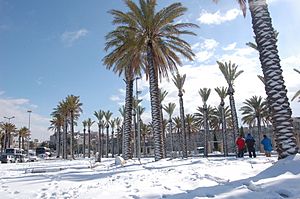
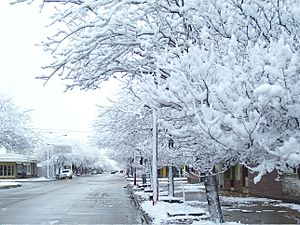

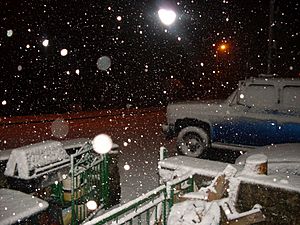
Some people define winter based on the Earth's position around the Sun. This is called astronomical winter.
- Astronomical winter starts at the winter solstice (the shortest day of the year).
- It ends at the vernal equinox (when day and night are equal length in spring).
These dates are a bit later than the meteorological winter dates. For example, in the Northern Hemisphere, astronomical winter is usually from December 21 or 22 to March 19, 20, or 21. Even though the solstice is the shortest day, the coldest part of winter usually comes a few weeks later. This is because it takes time for the Earth to cool down.
Different countries have slightly different traditions for when winter begins and ends. For example, in some Celtic nations, winter is thought to start on November 1st and end on February 1st or 2nd.
How Animals and Plants Survive Winter

Animals and plants have amazing ways to survive the cold and lack of food in winter.
Animal Adaptations
- Migration: Many animals, especially birds, fly to warmer places for the winter. Some butterflies also migrate.
- Hibernation: Some animals go into a deep sleep, lowering their body temperature and heart rate. They wake up when it gets warm again. Examples include gophers, frogs, snakes, and bats.
- Storing Food: Animals like squirrels, beavers, and raccoons gather and store food during warmer months. They then eat this stored food during winter instead of hibernating completely.
- Changing Appearance: Some animals change their fur or feather color to white to blend in with the snow. This helps them hide from predators or sneak up on prey. Examples are the rock ptarmigan and the arctic fox.
- Growing Thicker Coats: Many mammals grow a thicker, warmer coat of fur for winter. This helps them stay warm. They shed this extra fur when spring arrives.
- Using Snow for Shelter: Snow can act like a blanket, keeping things underneath it warmer. Mice and voles often live under the snow layer to stay insulated.
Plant Adaptations
- Annual Plants: Some plants, called annuals, only live for one growing season and die in winter. Their seeds survive the cold and grow new plants in spring.
- Perennial Plants: Many smaller perennial plants (which live for more than two years) are protected by the insulating snow. Larger plants, like deciduous trees, lose their leaves and go dormant (sleep) in their upper parts. Their roots are still protected by the snow.
- Vernalization: Some plants actually need a period of cold winter weather to complete their life cycle and bloom.
- Winter Blooms: Very few plants bloom in winter. One example is the flowering plum, which often blooms around Chinese New Year.
- Hardening: Plants prepare for cold weather through a process called "hardening." This makes them more resistant to freezing.
Famous Cold Winters
Throughout history, there have been some very cold winters that people remember.
- 1683–1684 ("The Great Frost"): The Thames River in London froze so solid that people held "frost fairs" on the ice for about two months!
- 1739–1740: This was one of the coldest winters ever recorded in the UK. The Thames froze again for about eight weeks. A terrible famine in Ireland during this time caused many deaths.
- 1816 ("The Year Without a Summer"): A huge volcanic eruption in Indonesia in 1815 caused very cold weather around the world the next year. Snow fell in New York in June, and lakes froze in July and August. This led to food shortages and famine in many places.
- 1887–1888: This winter brought record cold temperatures and huge snowfalls, especially in the US Midwest and East Coast.
- Early 1947 and 1962–1963: These were abnormally cold winters in Europe, with lots of snow.
Other notable cold winters include:
- 1310–1330: Many severe winters in Europe marked the start of the "Little Ice Age," a long period of colder weather.
- 1600–1602: Extremely cold winters in Switzerland and the Baltic region after a volcano erupted in Peru.
- 1779–1780: Scotland's coldest winter on record. The Hudson River and New York's harbor froze over in the USA.
- 1794–1795: A very severe winter in the UK, with the coldest January ever recorded in London. The French army even tried to invade the Netherlands by crossing its frozen rivers!
- 1813–1814: The last time the Thames River completely froze over and hosted a frost fair.
- 1976–1977: One of the coldest winters in the US in decades.
- 2010–2011: A very cold winter in the eastern USA with lots of snow.
- 2011: One of the coldest winters in New Zealand, with snow falling in Wellington for the first time in 35 years.
- 2011–2012: One of the warmest winters on record in some parts of the world, like Ireland.
Humans and Winter
Humans first developed in warm, tropical places. As people moved into colder areas like Eurasia, they had to learn to deal with winter. Over many generations, some groups of people, like those in Europe, Asia, and the Inuit people, developed small changes in their bodies that helped them adapt to cold climates.
See also
 In Spanish: Invierno para niños
In Spanish: Invierno para niños


